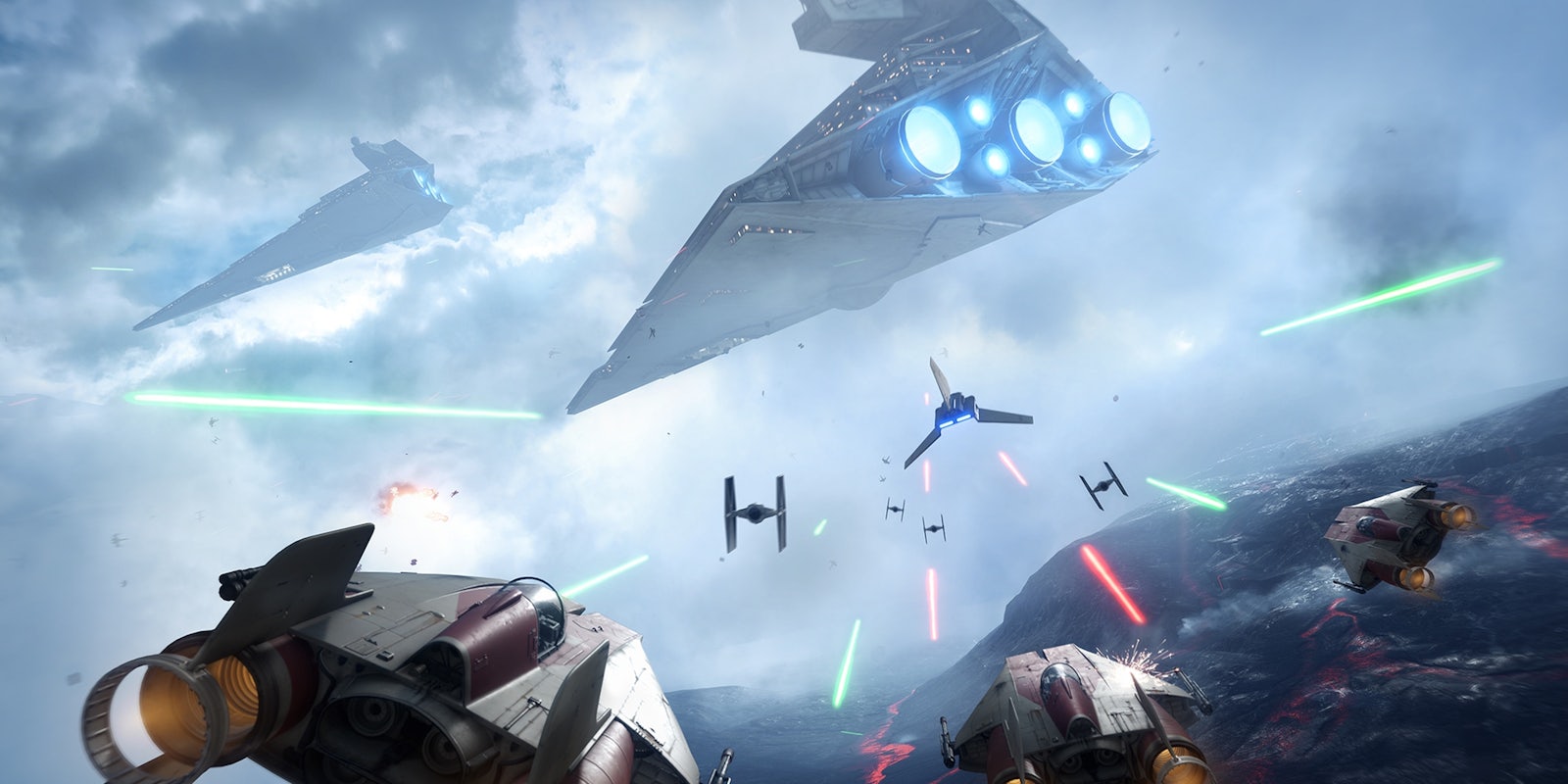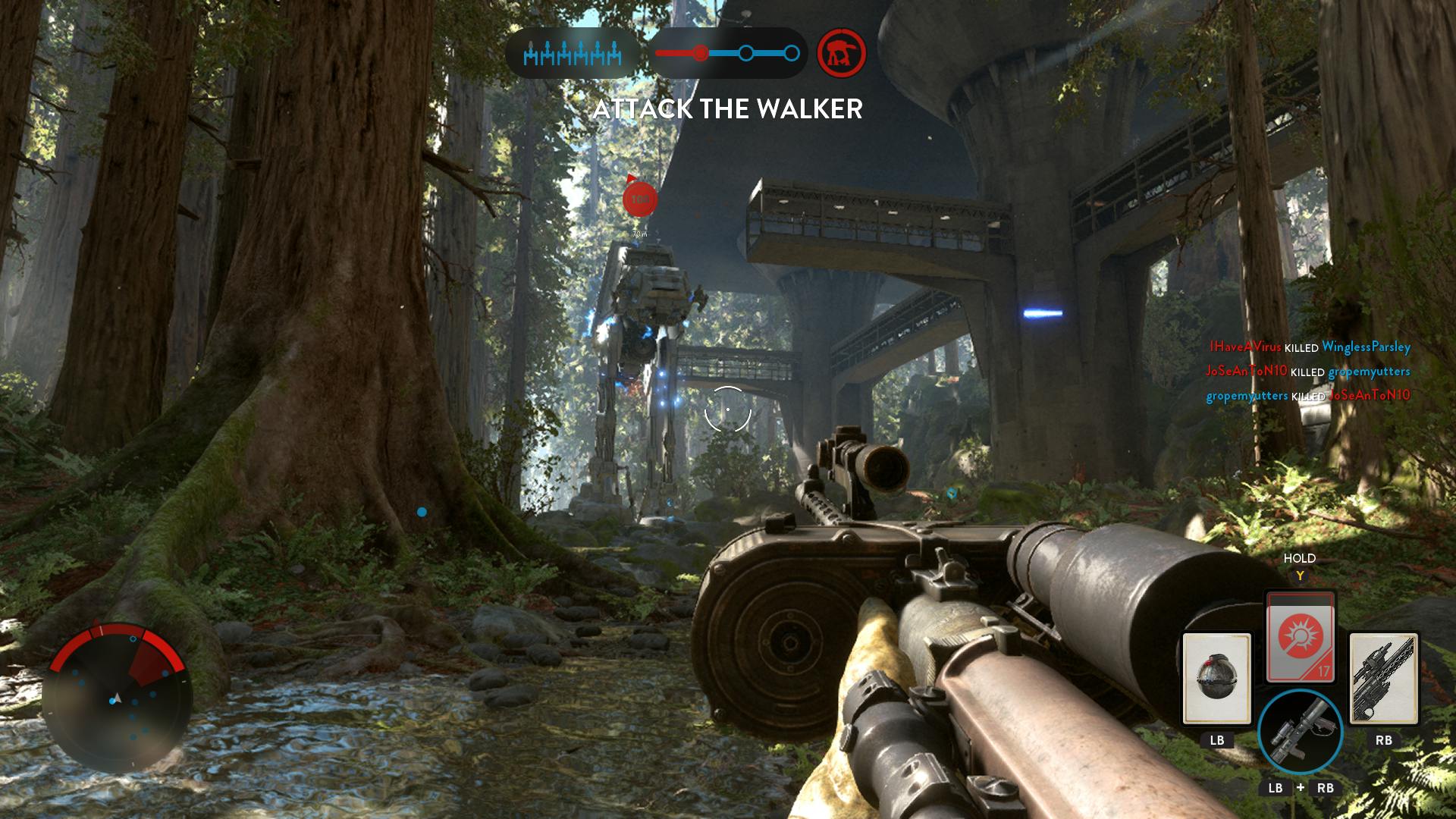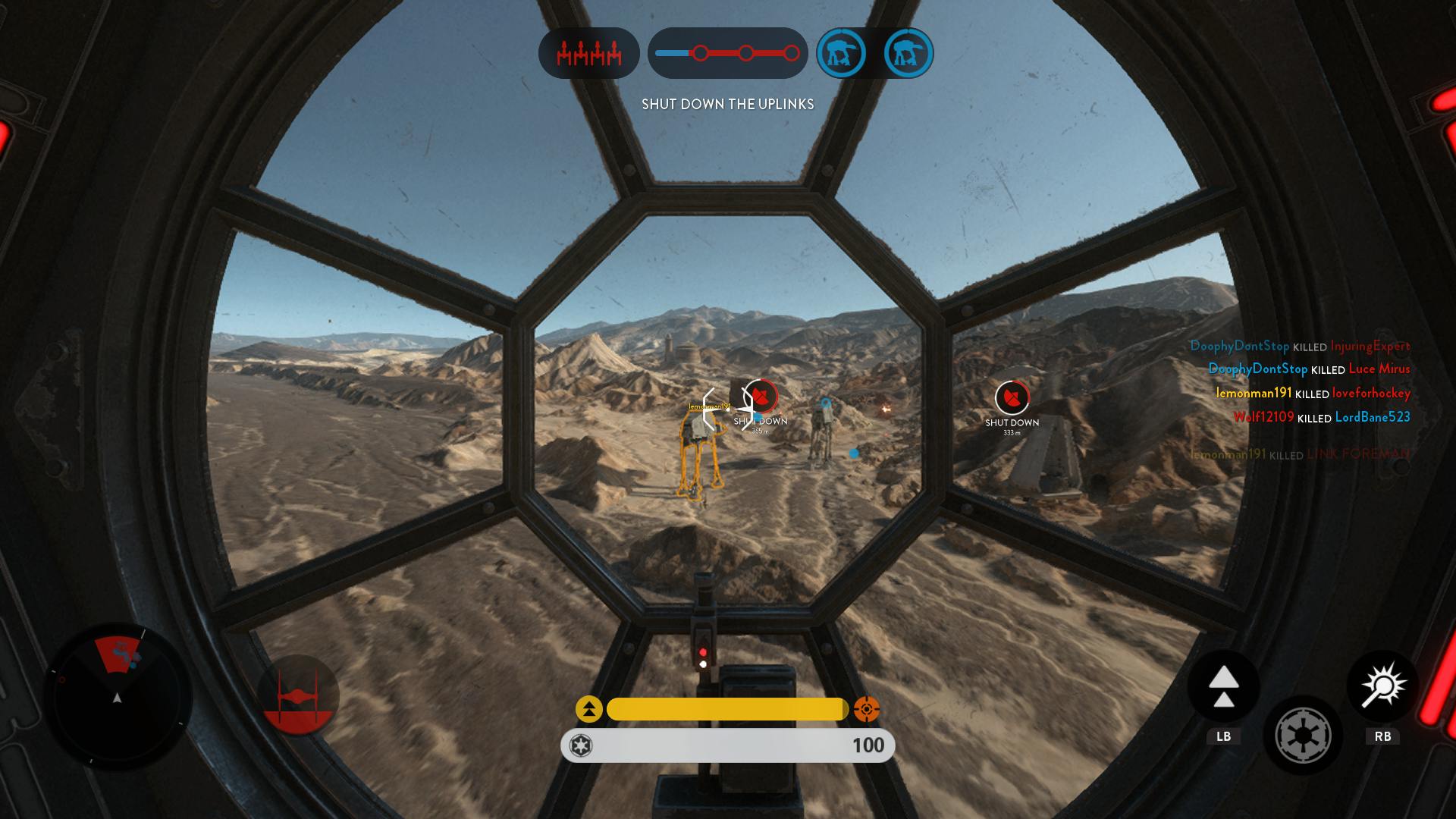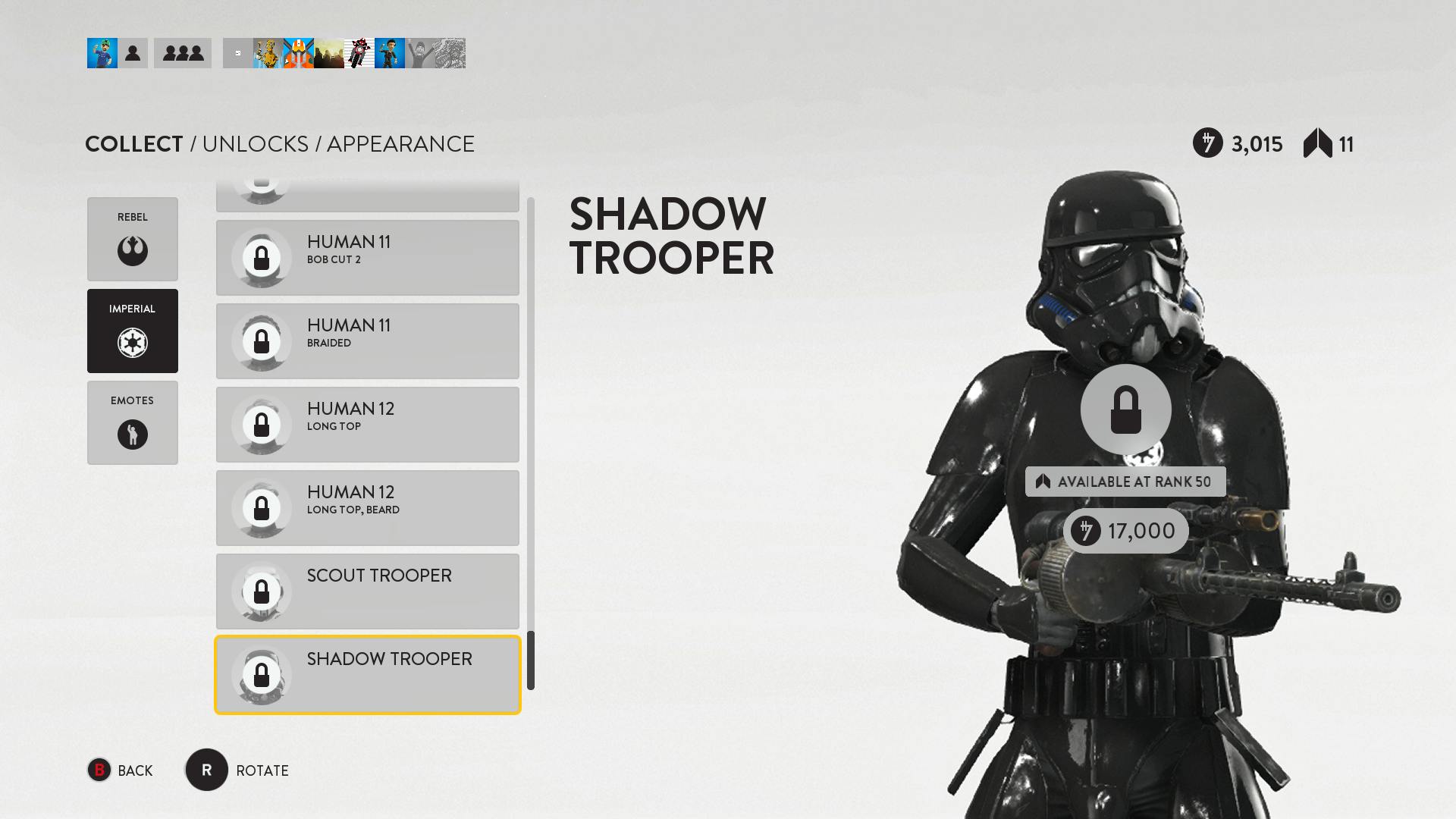Star Wars Battlefront looks and sounds more authentic than any other Star Wars video game developed to date. Nothing even comes close.
Battlefront is also not a game with strategy and tactics in mind. It’s designed for people who want to whoop and holler because, “We’re playing a Star Wars game!” Which is fine, of course. But dedicated shooter fans need to understand that the average Battlefront match has all the sophistication of two blunt rocks bashing into one another for a 10-minute stretch.
The value of an individual spawn in Battlefront is nil. If you last for 60 seconds before dying you’re probably on a really good run, then you respawn a second later to run straight back into the meat grinder. Battlefront is about throwing yourself into the breach like a Soviet conscript at Stalingrad and hoping that the man behind you kills the man that shot you dead.
If and when the appeal of its Star Wars authenticity rubs off, you might find yourself looking at Battlefront and seeing a shooter that feels bland, repetitive, and presents little competition for your attention compared to the other multiplayer shooters released this fall.
But then, I don’t think Star Wars Battlefront is intended for shooter aficionados who are better served elsewhere. I think it’s intended for Star Wars fans who might not play shooters at all.
The only variable that seems to matter in weapon selection is effective range, and even the baseline Rebel and Imperial blasters are extremely effective at long distances.
Heavy weapons don’t feel like they trade off fast fire rates for lower damage, even if the stats say they do. Kneeling makes you a smaller target, but doesn’t improve the quality of your aim.
You never have to worry about running out of ammunition. Weapons overheat when you fire too many shots in a row, but the weapons cool down quickly. The use of explosives also has a “cool down” period, but you never run out of ordnance.
If stealth is effective in Battlefront, damned if I can figure out how to pull it off, but I don’t think you’re supposed to play stealthy. All of the tactics and subtlety that define a well-honed multiplayer shooter are absent in Battlefront because it’s designed to be accessible.
Even playing Battlefront with a large team of friends I’ve been playing shooters with for a decade, I felt no sense of strategy where there normally would be some level of coordination even on the first day of a new release. Shooter skills and training usually translate from game to game.
Battlefront isn’t about team coherency and tactics. It’s about oohing and awing at the TIE Fighter that crashed right next to you while Luke Skywalker was Force-pushing your friend into a river of lava and you’re trying to shoot down the T-47 Airspeeder that’s trying to take down the AT-AT you’re defending—and bragging about it to your friends the next day.
There are nine multiplayer modes in Battlefront. Two of them—Walker Assault and Supremacy—have substance. They are the only two modes in Battlefront that incorporate all three pillars of the game’s design: infantry, vehicles, and Heroes. The remaining seven modes feel decidedly like padding.
Walker Assault is the mode in which Battlefront shines. It feels the most like an authentic, cinematic Star Wars experience in that it pits the Rebel Alliance in a desperate fight against the overwhelming military might of the Empire. Walker Assault almost would have been worth selling on its own, because everything else in the game pales by comparison.
In Walker Assault the Imperials have to defend a pair of AT-AT Walkers on Hoth, Sullust, or Tatooine, or a single AT-AT on Endor, as they steadily advance toward a Rebel objective. The Rebels have to hold a pair of uplink towers to call in Y-Wing bombers to attack the AT-ATs and make them vulnerable to taking damage.
The uplink towers are practically out in the open, which means they are extremely difficult to take and hold from the Empire. The area around the uplink towers is a cornucopia of awe-inspiring explosions amid a flurry of red blaster bolts and screams. It’s harrowing and fantastic.
Supremacy is similar to Rush mode in the Battlefield series. There are five control points on the map that have to be attacked in succession. You cannot take and hold point C unless you also hold point B, so you’re always frantically bouncing between two points while dodging all the different ways that people are trying to kill you: snipers, dive-bombing attacks by vehicles, maniacs with lightsabers, and grenades so loud that they deafen everyone in the immediate area for a moment when they go off.
Walker Assault and Supremacy more or less come down to where the metaphorical meat grinder happens to be located at any given time. The strategy is the same in both modes—throw more bodies at the objectives than the enemy has bullets to stop. It’s pure chaos set to the John Williams Star Wars score, with photorealistic weapons and uniforms based off props stored in the Lucasfilm archives and perfect sound effects taken right from the films.
Single-use powerups on the battlefield offer automated and manned gun emplacements, powerful ordnance, shield generators, and access to the Heroes and vehicles (we’ll return to those later).
Blast mode is Battlefront’s version of Team Deathmatch. Cargo mode is Battlefront’s version of Capture the Flag. The objective in a Drop Zone match is to seize and claim the escape pods that land in random locations on the map. Droid Run is like Domination mode, but instead of seizing-and-holding three different flags over time to score points, you have to activate a trio of Gonk droids and then maintain control over the droids as they amble around.
All four modes take place on small maps, are defined by the same fast-death-and-respawn gameplay as the larger modes, and are far less interesting than Walker Assault or Supremacy.
There are two multiplayer modes in Battlefront built around Heroes. Each Hero has three special abilities, and the Empire comes out far better in a comparison of the choices. Boba Fett has a jetpack, a flamethrower, and a rocket launcher. Darth Vader can block blaster bolts with his lightsaber, Force choke people, and hurl his lightsaber in a ranged attack. The Emperor kills people with Force lightning and executes mad dashes across the battlefield.
Luke Skywalker can also block blaster bolts with his lightsaber, has a Force push, and can execute a dash attack. I’ve played as Han Solo and Princess Leia several times each, and honestly couldn’t tell you their special abilities from memory for how nondescript and unimpressive they felt. Given a choice between the three, it’s a no-brainer for me to choose Luke every time.
In Hero Hunt mode, one player is the Hero while everyone else on the Rebel and Imperial teams is a regular infantry class, and both teams compete for kills. In Heroes vs. Villains mode, each side has all three Heroes on the field at the beginning of the match, and the first team to kill all of the other team’s Heroes wins.
When you get to play as a Hero character all the time, the idea of playing as a Hero loses its allure. In Walker Assault and Supremacy, picking up a Hero powerup is a thrill because a well-played Hero is a force of chaos that for a time can completely change the course of the battle.
One of Battlefront’s glaring weaknesses is the way the game handles vehicles. In the original Star Wars Battlefront games released in 2004 and 2005, vehicles were located right next to infantry respawn points, so you could load into a match and hop right into a vehicle.
In the new Battlefront the vehicles are powerups, which means you have to find them on the battlefield and hope they’re not being camped by the enemy—a smart way for the opponent to get kills. Concentrating on finding vehicle powerups rather than actually fighting the enemy is also an excellent way to die repeatedly.
The average amount of time I spent in vehicles in the new Battlefront is much less than the time I spent in vehicles in either of the original two games, and riding in Star Wars vehicles is supposed to be a huge portion of the fun. I would gladly trade off the frustrating inability to locate and procure vehicle powerups for the frustration of being beaten to vehicle spawns I could at least procure safely when they were available.
If you want to make sure you can always get a chance to fly in an X-Wing, A-Wing, TIE Fighter or TIE Interceptor, you can at least turn to Fighter Squadron mode, an attrition-based game that’s all spaceships, all the time. Powerups for Slave 1 and the Millennium Falcon are available, although you have to find and claim them before anyone else does.
The other, quality vehicle experiences in Battlefront for me had nothing to do with other players. The Endor Chase training mission introduces the mechanics of riding speeder bikes, and is far more fun than trying to ride them through multiplayer maps that are too small to allow for high speed chases.
I’m not sure what speeder bikes are actually supposed to do in Walker Assault mode on the Endor map other than to serve as distractions that get you killed with no benefit to your team.
The single-player vehicle training mode called Invasion replicates one of the most iconic Star Wars battle sequences of all time, when the Rebels take down Imperial AT-ATs with snowspeeders and tow cables during the Battle of Hoth.
I’ve seen people take down AT-ATs with airspeeders in Walker Assault. I’ve never managed to pull it off because it means being able to get an Airspeeder powerup before someone else does, at the same time the AT-ATs are temporarily vulnerable to damage, and without getting killed by either TIE Fighters currently in the air, or AT-STs, or infantry armed with anti-vehicle weapons.
So instead of dealing with that frustration, I went back to the Invasion training mission whenever I wanted to have some fun with airspeeders and AT-ATs. There’s something wrong with a combined-arms shooter game when you have to step into the tutorials to have fun with some of the vehicles.
The original Battlefront games were based on different classes of ground units like regular infantry, heavy infantry, snipers, and pilots. The new Battlefront ditches the idea of player classes in favor of the new Star Cards system, which is much more flexible and therefore a marked improvement.
Star Cards are unlocked as you earn experience and increase your Rank and are purchased with Credits that you earn at the end of each match. You can build a “hand” of three Star Cards that grants access to ordnance like grenades and mines, secondary weapons like sniper rifles and pistols, and abilities that increase the power of your primary blaster.
You can save multiple hands of Star Cards as if they were character builds, and swap them out on the fly during a match. You will probably remain a blunt instrument with a short lifespan in Battlefront no matter what hand of Star Cards you’re holding, but with the right cards you can at least do a lot more damage in that short of amount of time.
Star Cards are half the inducement to hang in with Battlefront for the long haul. There are also a ton of customization options to unlock, over 70 different head/outfit combinations for Rebel fighters, and a little over 50 options for Imperial Stormtroopers. Every unlock has to be purchased with Credits, which will keep completionists grinding for a long while.
Unfortunately, the Imperial customization options are almost entirely the same sets of heads that Rebel characters can choose, and Imperial Stormtroopers without helmets are just silly at best. The only cool options for Imperials—Scout Trooper and Shadow Trooper armor—will take a long time to unlock. Imperials really get the short end of the stick when it comes to customization.
The Battlefront servers are wonderfully stable for a multiplayer game released by DICE and Electronic Arts. To see no slowdown or chug in a game this graphically advanced when 40 people are hooking in from independent connections is precisely how it should be.
Unfortunately, the party system in Battlefront feels wonky at best. I’m still trying to get a handle on it. You have to form up within Battlefront’s main menu, in addition to being in a Party on Xbox Live. You can send Battlefront party invites via a list of Xbox Live avatars at the top of the screen that represent all of your friends who are currently online. Even though I was talking to friends via Xbox Live Party chat at the time, I sometimes couldn’t find their avatars in that list.
Once you’re in a Battlefront party, the leader can select a mode and load into the game, but the entire party isn’t added into the game at once. Instead, each person in the party receives an invitation they must accept individually. Likewise, you all have to quit a game individually, rather than being removed from a game as a party.
It’s an awkward system that breaks party coherency when smoothly forming parties and keeping them together as they move between game modes is a minimum expectation of any multiplayer game nowadays. At least Battlefront also offers smaller two-player co-op modes like the wave-based Survival Missions that require less effort to keep your group together.
As long as you focus on the hum of lightsabers and the scream of TIE Interceptors and the bark of blasters you can distract yourself from all of Battlefront’s shortcomings. This is a game whose essence you could grasp in a few day’s play, after which it’s time to dig in, grind, and collect all the unlockables.
DICE and Electronic Arts are already selling a $50 Season Pass for four expansions, which adds to the ways Battlefront feels like a scaffold for things to come. What’s going to be included in those expansions?
Maybe a space battle mode that would have added already-needed depth to the vehicle gameplay in the current vanilla release? Maybe some other, new game modes that can stand toe-to-toe with Walker Assault and Supremacy?
Let’s call a spade a spade: Battlefront is a release that’s taking smart advantage of the current wave of nostalgia sweeping culture in expectation of The Force Awakens. It’s not for nothing that the pre-order bonus for Battlefront was early access to the Battle of Jakku map—a key link between the events of the original trilogy and the story that begins decades later in the new movie.
That nostalgia, much more than the current depth offered by Battlefront is going to drive adoption of this game. You’d probably be better off waiting to see what the expansion packs are going to offer, and then getting the total package for much less than the $110 it’s going to cost you if you buy everything on release. Then again, who wants to wait for their Star Wars video game pew-pew fix when it looks and sounds this good?
Disclosure: Our Xbox One review copy of Star Wars Battlefront was provided courtesy of Electronic Arts. Battlefront was also released for PC and PlayStation 4.
Illustration courtesy of Electronic Arts.







